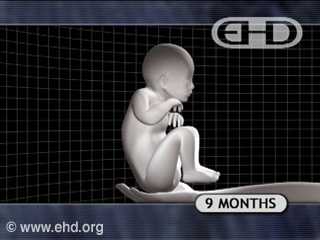Prenatal Form and Function – The Making of an Earth Suit
Unit 19: 9 Months to Birth (36 Weeks to Birth)
 Closer Look:
Closer Look:
 Applying the Science:
Applying the Science:

Copyright © 2006 EHD, Inc. All rights reserved.

During the last 11 weeks of pregnancy, the fetus typically doubles in overall weight, while brain weight doubles in the last 9 weeks of pregnancy.1 Much of the brain’s weight gain is due to the thickening of the myelin sheath around the nerves. By the end of pregnancy, the fetal brain is about a quarter of its eventual size and contains nearly all the neurons it will ever have:2 perhaps 100 billion (1011). Each of these neurons will eventually synapse with as many as 200,000 other neurons,3 creating an electrical network of almost incalculable complexity.


Copyright © 2006 EHD, Inc. All rights reserved.
The eye of the full-term fetus or newborn has achieved roughly 75% of its adult size and about two-thirds its adult weight.4


The fetus initiates labor resulting in the transition from fetus to newborn.5 Powerful contractions of the uterus result in childbirth and the expulsion of the placenta, which now weighs about 1/6th as much as the newborn.6 At birth, the oxygen received through the placenta is suddenly replaced by the onset of air breathing.
Conclusion
From fertilization to birth and beyond, human development is dynamic, continuous, and complex. New discoveries about this fascinating process increasingly show the vital impact of fetal development on lifelong health. As our understanding of early human development advances, so too will our ability to enhance health – both before and after birth.

| 1 | Jordaan, 1979. 146. |
| 2 | Robinson and Tizard, 1966. 49. |
| 3 | Guyton and Hall, 2000. 512. |
| 4 | Robinson and Tizard, 1966. 51. |
| 5 | Liley, 1986. 10; Liley, 1972. 100. |
| 6 | Cunningham FG et al., 2001. 252. |



